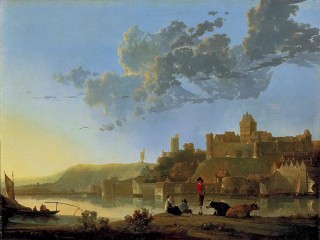
Aelbert Cuyp biography
Date of birth : 1620-10-20
Date of death : 1691-11-15
Birthplace : Dordrecht, Netherlands
Nationality : Dutch
Category : Arts and Entertainment
Last modified : 2010-11-09
Credited as : Artist painter, ,
The landscapes of the Dutch painter Aelbert Cuyp are famous for their golden light and alluring color. He painted Dutch rural life in its full variety.
Born in Dordrecht, Aelbert Cuyp was probably first taught by his father, the painter Jacob Gerritsz Cuyp, known mainly for his portraits. Between 1640 and 1645 Aelbert painted skillful monochromatic dune and river landscapes with diagonal compositions, much in the manner of Jan van Goyen.
Because of the scarcity of dated works it is impossible to say precisely when Cuyp introduced the misty golden light that is the hallmark of his mature style, but it was certainly in the 1640s. This innovation was based in part on his observations of the optical effects of moist atmosphere; this was a time when optical experimentation attracted widespread interest among the Dutch. The many drawings and paintings Cuyp made of activities on the rivers that made Dordrecht a busy port in his day give evidence of his scrutiny of subtle variations in light effects. The major impetus for this interest, however, probably came from Jan Both, who returned from Italy to Utrecht in 1641 and painted there until his death in 1652. To Claude Lorrain's unprecedented demonstration of the unifying power of light in landscape painting, Both added a new specificity through attentive study of appearances at different times of day. This approach was central to Cuyp's mature achievement. The particular light of a given moment became part of his subject. In his ability to translate specific light effects into paint, he surpassed his models and created landscape paintings of unique poetic sensibility.
As is clear from his Young Herdsmen with Cows (ca. 1655) Cuyp ensconced his soft, golden luminosity in firmly structured compositions. The monumental cattle, silhouetted
against the sky, emphasize the aerial perspective and create the illusion of a visual field of vast depth. Considered relationships and classical restraint likewise contribute to the calm perfection of his matchless scenes of moonlight on the water, for example, Sailing Boats and Mill. As Cuyp apparently never went to Italy, it seems that his Italianate scenes, such as Travelers in a Hilly Landscape, depend on works by Both and other Italianizing Dutch artists.
Having achieved sudden affluence through marriage in 1658, Cuyp painted little thereafter. There are no dated pictures after 1655.
Wolfgang Stechow, Dutch Landscape Painting of the Seventeenth Century (1966), deals perceptively with Cuyp's development and his place within the Dutch landscape tradition. See also Jakob Rosenberg, Seymour Slive, and E. H. Ter Kuile, Dutch Art and Architecture, 1600-1800 (1966). Two older works which include chapters on Cuyp are Eugène Fromentin, The Masters of Past Time: Dutch and Flemish Painting from Van Eyck to Rembrandt (1876; trans. 1913; new ed. 1948), and W. Bode, Great Masters of Dutch and Flemish Painting (1906; trans. 1909; rep. 1967).
Reiss, Stephen, Aelbert Cuyp, London: Zwemmer, 1975.
Reiss, Stephen, Aelbert Cuyp, Boston: New York Graphic Society, 1975.
















